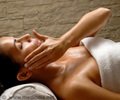Whether it's triggered by the monotone of an instructor or insufficient rest the night before, students at all ages and grade levels sometimes have trouble staying awake in class. Researchers have now found a way to combat the sleepiness and to keep students awake during class, and it doesn't have anything to do with caffeine or high-sugar snacks.
Students can increase alertness by applying acupressure at stimulation points to keep themselves active. Students in a class who were taught to self-administer acupressure treatments to stimulation points on their legs, feet, hands and heads were more alert and less fatigued. The study showed that a stimulation acupressure regimen leads to a statistically significant reduction in sleepiness compared to an acupressure treatment that focuses on relaxation.The 39 students who participated in the study were in the On Job/On Campus executive education program and were participating in three days of all-day lecture classes. Students were taught how to self-apply acupressure regimens on either five stimulatory points or five relaxation points. The regimens consisted of light tapping with the fingers, and massaging with thumbs or forefingers.
The class was divided into two groups. One group of students was asked to self-administer acupressure to the stimulation points on the first day, followed by relaxation points on days two and three. The other group self-administered relaxation for one day, then stimulation for days two and three.
Sleepiness was assessed by the validated Stanford Sleepiness Scale, and students rated their levels of sleepiness in the morning, before class began and in the late afternoon, at the conclusion of class. Acupressure was administered mid-day during the lunch period.
The fact that the stimulation group had significantly less fatigue than the other group has interesting implications for future studies of acupressure.








